Communication is the essence of a community, and I was fortunate enough to land myself in the Takaka community at an amazing time. This weekend the Community Gardens hosted a Sustainable Golden Bay Event, and I had the privilege to participate with a wide variety of people from the region coming together to work on making their region a better place. Several workshops over two days have given me a strong insight of issues and solutions present in the area, and have inspired me to bring back the ideals of this event to the Olympia community.
The place:

Pizza oven, baked goods for sale, and cups of tea offered in the front space

Seed garden
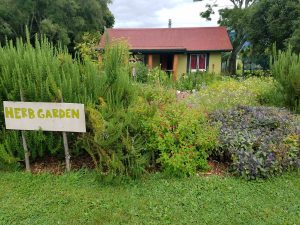
This patch smells delightful!
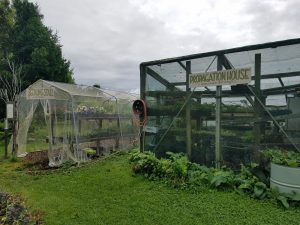
Lots of growth going on here- both in plants and people!
The first workshop I attended was all about network mapping, in which locals listed all of the natural resources, businesses, organizations, cultures, and systems present in the immediate surrounding town. We then discussed which areas were draining un-renewable resources, and areas that could use some improvement in the field of environmental consciousness. Some key sectors identified were large dairy operations, logging in nearby hills, and the pollution of the Takaka river. One participant suggested that they could build a 3D model of this “map” in a public space and allow people to come in and write suggestions on how we could change our use of resources and the connections that link them together. I found this to be a powerful and important first step of the event, as everyone was able to come to a shared awareness of where they live and have it fresh in their minds.
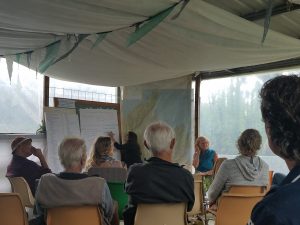
Identifying key characteristics of Takaka
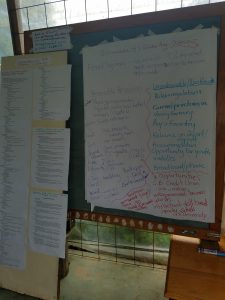
Our list of resources (the upload quality is really low unfortunately)
Following this, Sean Weaver gave a talk on how society as a whole can ‘scale up’ our sustainability in the most efficient way possible. He explained that there is a sort of bell curve of lifestyles, those who hold an aversion to adapting eco-friendly practices at the bottom, those who use some sustainable ideals here and there but could use further education and implementation at the peak, and those who already have lots of environment-positive activities going on in their daily lives. Sean’s opinion is that to make a big step, we should focus our energies on the people at the top of the curve, providing them with suggestions for simple solutions they can introduce into their regular actions. The discussion that followed this was stimulating and inspiring, as we were invited to talk about how best to get our messages across to people who may not know as much about caring for the earth sustainably. We came to agree that we must first listen to the reasoning behind the other persons ideas about what they are currently doing, and then gently identify the problem but spend most of our time discussing strategies for fixing it. Sean brought to the table the fact that in activism attempts, if more than 20% of what you say is negative, the positive solution you are trying to get across won’t be received. Another criteria we came up with was the idea of trying to ‘take down the fence’ rather than try to pull one another to one side. Once common ground and shared values are established, change can occur because the idea of being adversaries falls away. After setting some guidelines for how these conversations can happen, we brainstormed what conversations should be happening. Particularly, I learned, people in Golden Bay are worried about soluble fertilizers in waterways, poor stock management, over-intensification on the land, monocultures, and corporate involvement. To further examine the root of the problem, we identified some causes of these issues to be economic drive, closed mindset, and the general difficulty to go against the grain of mainstream culture. The main solutions we could think of were to simply be a model, take a stand against something if you don’t think it’s the right thing for the earth. Pave the way for people to follow you by fighting for changes in policy and showing that it can be profitable and satisfying to create sustainable operations. What was really touching for me about this chat was the diversity of people at the table, we had farmers with lots of land or just small gardens, shop owners, students, teachers, café workers, artists, musicians, and so many more. All of them had two important interests that I observed; they want to preserve the land they live on, and they want the people who inhabit it to flourish.
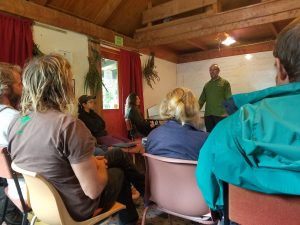
Sean leading our chat
The next workshop took a look at what is called “Life Cycle Assessment”, a practice where every item used in a household is examined for environmental impact. The journey is mapped out to discover things like the carbon footprint, transport and disposal methods, and energy usage. After quantative meausurements are taken into an inventory of inputs and outputs, alternatives are considered and weighed out in a balance. Sometimes even though, for example, energy usage is decreased, ecotoxicity might be increased. Social aspects can be considered as well, for example giving an afternoon off to workers who may be dealing with struggles in their life may increase their productivity as they feel more compassion for the company. Furthermore, increasing wages can also lead to increase in profit even though more money is being spent to pay workers, because they will be motivated to channel all of their effort into the time they are working. The Takaka community brought up the point that they lie in an isolated valley surrounded by really tall hills, and every item that has to come over these hills has a huge impact on the environment because it takes lots of gas to drive over them. Therefore, those who live here need to be incredibly aware of how they can try to source things locally whenever possible. It’s quite inspiring because I know that this effort isn’t just an idea- there’s plenty of little shops and markets 3 times a week offering hand-crafted, community-produced products. I feel refreshed seeing a localized society really pushing to make their economy central and break away from larger enterprises, opting to work together to create a chance for reducing the harmful tread civilization has on the world.
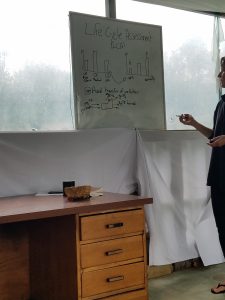
Marie assessing the environmental impact of the marker she’s using to write on the board
We continued our stream of ideas for change by talking through a panel-system, with the community gardens organizing five speakers to mediate conversation and answer questions. Five voices were present, including Richard Kempthorne (mayor of the Tasman District Council), Kate Fulton (green party member), Sue Brown (Fonterra shareholders councilor), Abbie Langford (from the Golden Bay Community Board), and Siti Jongkind (Golden bay high school student). I find it incredibly brave that these members were all so ready and willing to step up to the plate and participate in this discussion. Fonterra (which Kate Fulton supports) is the largest dairy operation in the country, and actually a huge international corporate company encompassing 13,000 dairy farms. It is because of Fonterra that many small, localized dairy farms have struggle selling their milk because they can’t compete with the supermarket prices that Fonterra offers, and many of the environmental concerns discussed earlier in the day (poor stock management, over-use of land, corporate involvement) were targeted directly towards Fonterra. However, the fact that Kate was here and now, sitting down to talk with those who disagree with the company, proves that positive change is definitely possible. A saying I’ve heard, ‘If you can’t take the heat, get out of the kitchen’, came to mind as I witnessed her take a seat right in the spot. However, it wasn’t an intensive debate or battering, the community did a really good job of remaining positive and using positive tactics to create a warm approach. One person in the group had a really good idea of actually making a small Fonterra processing facility in Takaka that just collects milk from Fonterra farmers here. That way this collecting tank can service the supermarkets on this side of the hill, rather than using valuable petrol to transport it across the steep slope to be put into a tank, and then being sent right back over again. Another suggested that she work with Fonterra farmers to assess if the amount of dairy cows they have is the most economically efficient number. A woman named Nicky mentioned this, and explained that when she took cows out of production, she actually started making more milk, because more grass per cow meant more milk per cow. Thus, costs went down and profit rose. Kate seemed open to these ideas and I think that’s a huge step in a good direction. I truly applaud Kate for stepping into the mouth of the lion and hope that she realized that the community just wanted to gently recommend things rather than grill her. Though I’m sure she felt intimidated at first being in a room full of people that disagreed with what she stood for. Other topics were tossed around as well, another major one being that the community feels that climate change is encroaching more and more on their environment and the government isn’t acting fast enough to make a difference. The conversation was ignited by a woman asking “Is it possible for the systems we have to respond in time to community concerns about climate change, and if not, why should we continue to support these systems?” Richard and Abbie, both being government representatives of these people, responded by saying that in a democracy, things take a long time to process. It is the most effective form of government because it considers the voice of those who live with the policies, but this means debate is slow since there is lots of differences in terms of how to enact strategies of change. Both officials agreed that the councils and boards aren’t acting as fast as they’d like, and that in the mean time it would be beneficial for members of the community to take some actions (within the boundaries of current laws) without trying to pass complicated policies through the legal system. A specific issue in which this is applicable is that the council is currently trying to ban the use of soluble fertilizers, at least within a certain distance from freshwater, but it’s taking ages to get pushed through. Community members are now discussing working with the farmers that are causing this problem directly to convince them to just stop or slow their usage of chemicals without government enforcement. This dialogue was special to be apart of, even though I was mostly a listener as to not draw away from the local voice, because I could literally see people opening their minds to new ideas and innovative ways of managing the region.
Sunday morning began with a talk on agroforestry, primarily focusing on implementing edible crops in the understory of the gigantic pine logging areas. Pines aren’t native here, but there are pine plantations all over the area because pines grow much faster than the native trees and therefore have quicker economic turn around. Courtney Brookes and Phoenix Hursthouse led the talk, and showed many examples of successful food forests, both around the area and all over the world. While growing native edible shrubs underneath the alien pines would sound like the optimal option, there really aren’t any marketable food crops that come from native plants, so the logging companies wouldn’t be too keen on putting them in. The edible crops that could be planted don’t necessarily have to be native as long as nutrient cycling and sun/water requirements are considered to chose plants that could work well with the system. To further reduce erosion, another benefit would be convincing the logging companies to only cut selectively, chopping down trees from different areas of the plantation as the demand comes about. Many of the large pine operation owners are actually very willing to begin using these practices because of the education that people like Courtney and Phoenix have been sharing. When these companies plant forests, they know that they are long-term investments in which they don’t see a financial return for many years. The fact that they could be making money quicker by producing high dollar crops like ginseng and shitake mushrooms is very appealing. Additionally, when they later go on to market their wood, they have the added plus of getting to claim that they are preventing erosion and making better use of the land they own. Another way that food forests could become a larger part of Golden Bay agriculture is by alley cropping, in other words, planting rows of trees with either sectors of vegetable production or grazing pastures in between. Given the huge amount of sheep and cow farms in the area, there’s plenty of room for trees to really make a difference by being a part of these systems. The passion that the two speakers had in talking about creating these changes was huge, and they have a goal to spread their message across the country and hope to see food forests become the source of 50% of the south island’s food supply by the year 2100. With the momentum and dedication that they possess, and their tenderness in talking with farmers about how to get these systems established, I believe that goal is surely within reach.
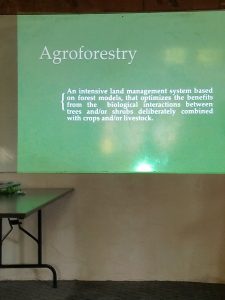
First slide from a very informative power point
My next hour was spent listening to the Rhodes family talk about their dairy farm, and current issues in the industry. Their property is home to 135 cows who all have names and personalities that they’ve taken the time to get to know. It was enchanting to see their smiles as they talked about them, and how they scratch each one of their heads as they enter the barn for milking every day. They are enthusiastic about managing their land well, rotating cows to a different pasture every other day, and lining their paddocks with wide shelter-belts of shrubs and trees. Someone in the audience asked about the effect of compaction from their farm, which can cause run-off during heavy rains. They explained with a rather intriguing answer, that their soils were incredibly high in humus from all of the manure implements throughout the years, which grabs on to nutrients and holds them without allowing much to leech through. They actively test both their soils and the water in the stream that runs through the land (protected by a thick riparian buffer zone) to ensure that they aren’t causing trouble. They also supplement their soils with lime and magnesium to prevent soil plugging. I think the Rhodes family is a real role model for maintaining viable dairy systems, and I hope their knowledge can reach some of the farms in the area that could use improvement in terms of ecological awareness.

Expressing love for cows and community
The first afternoon workshop consisted of three organic farm owners talking about their experience in the field of local agriculture. Kokalito Organics discussed their usage of food forest like practices by keeping sheep in an orchard area, and their desire to farm here because they wanted to provide jobs for locals that they could feel good about. Parapara farms, which just began 15 months ago, expressed their love of the birds that live amongst them. They have large patches of native forest surrounding them, and the bird population works wonders for keeping their pest problems down. They’ve even furthered the birds involvement on the farm by providing wekas (a native flightless bird that feeds on slugs, snails, and even mice too) with brush habitat and interesting sticks to play with. They are also huge on beneficial insects and have introduced parasitoid wasps and lady beetles to reduce pressure from aphid and whitefly. Bay Subtropical Farm started with parents who first wanted to grow good food to feed their young children but ended up loving it so much they turned it into a full time job. They now sell a lot of mandarins, because they are easy to peel and contain 3 times the Vitamin C of oranges, and they market them to other parents as the perfect snack to put into lunch boxes. They focus on selling nutrient dense food, and use things like liquid fish fertilizers to really boost the quality of what they provide.

Progress on solutions for the Takaka area extended as we gathered to learn about Sustainable Youth Initiatives (SYI). Siti Jongkind, the high school student from the panel, and Claire Webster (an EnviroSchool representative) presented their goals for the future of the younger population wishing to get more involved in conservation. EnviroSchools is a program in this country that allows schools to become certified as a body of students and teachers that take action to protect their local environment. At Golden Bay High School, the students are motivated to really take this idea to the next level. They established a ‘crew’ through an organization called Earth Guardians, consisting of those who want to be leaders in ecological preservation. One thing they like to do is get together to create music and art that channel their feelings about changes they want to see. They follow events and issues in the ‘adult’ community and back them up with the voice of youth, even having their own collective seat on the district council, giving them the ability to speak at committee meetings and allow their opinions to have a real voice. The current goal they are focusing on is making their school 100% zero waste. They work with the community gardens already a little bit, having their own plot where they grow snacks to offer students, and now they are looking at using the worm farm here to dispose of things like food scraps, paper and magazines, and even water that has paint dissolved in it (which apparently worms can digest just fine). Deliberation on how to enact this occurred as they discussed with the garden management here as to who would be responsible for sorting, if students needed to help take care of the worm farm because they’d be using it, and how to get funding for bins and make signs explaining what can and can’t go in. I witnessed the birth of a new idea, too, as a member of the water department in the Department of Conservation invited the student group to join him on his weekly water testing of Pupu springs. The project is on Maori land and his job is to monitor the quality of their drinking water and take action to protect it if pollution becomes a major threat. Siti expressed strong interest in gathering her colleagues to help. I am astonished at the determination and hope in the minds of the younger population here, and wish I could have had a group like this to join when I was in high school. Fortunately, at Evergreen we have many opportunities like this to be apart of! It stirs hope in me to see that it’s happening all over the world too, especially in the young generation. One cool difference that I see across the ages is that while the older people seem to feel obligated on focusing on the politics of things, the younger groups tend to be more interested in actually using their own minds to put their hands to good use. This is a very inspiring notion because it means we can get a lot done in terms of taking charge of our future.
The final meeting was a gathering of many people to share new ideas that have sprung from this event about strategies for getting some solutions in place. Five people pitched their ideas, and then we split off into small groups to brainstorm further on them.
Pitches:
Problem- lack of awareness in collective agriculture community
Solution- sustainable agriculture hui (a hui is a Maori protocol, where a group of people gather at a local marae and follows a set of steps to come to a goal of shared understanding)
Problem- government not acting fast enough
Solution- forming a committee separate from the government to act on issues they can do something about
Problem- plastic bag usage
Solution- introduce tax or ban for stores that use them, or find funding for biodegradable bags
Problem- proposed widening of the highway to accommodate traffic
Solution- create an online carpool service
Problem- voices without a place to speak
Solution- organize a festival with music and art for people to express activism ideas and spread knowledge
All of these ideas are amazing game-changers that I hope get more development than what we accomplished this weekend. We split off into small groups to brainstorm further on each concept, beginning with listing our visions for what the end goal might look like. Then we wrote down what steps would have to be taken to get there. I was part of the group looking into a non-legal committee of people taking action. We discussed having rotational leadership, allowing anyone to join and participate, focusing on one issue at a time to channel maximum energy into it, and the need to set achievable goals.

Cooperating to find visions and methods for acting

Presentation of brainstorming
Overall, even though everyone that participated this weekend only put in 12 hours of time, we got so much done and everyone learned a lot. The community gardens are already planning to get people together for one more full day in a few weeks to continue developing new projects. After attending and learning some practical techniques for enacting sustainable strategies, I am really hoping to instigate some sort of event (maybe on a slightly smaller scale) in Olympia. I have the contact information of the coordinators and speakers that planned this weekend, and they are happy to help in whatever ways as I figure out how best to go about it. I’m hoping to get many Evergreen students and faculty together with interests in conservation or ideas about the future to try to contact and bring together people in the legislature, USDA officials, farmers on both large and small scales, business and home owners, high school teachers and students, people in the Nisqually tribe, and anyone else who might have something to say. Perhaps we could all gather in the Longhouse or the library, if we can get the school on board. This event could be a really powerful time where we can identify different ways in which our resources could be better managed and work together to come up with effective solutions. I am feeling empowered and driven to enact these kinds of changes in America, where we need them desperately. The “big guys” (i.e. federal government, huge corporations, commodity markets) will only change when they see many “little guys” (grocery stores, local government, small businesses) making a difference with the support of the people. I think Olympia has the capability to be a model, we have a strong liberal community who are very aware of environmental issues and passionate about changing them. The more sustainable we can become, the better example we can set for the rest of our country.













I would just like to say reading your blog has been very uplifting and inspiring. Maybe its all the sun in your photos, but I keep reading your blog with this bright and cheery voice. Not to mention the content itself is very uplifting! People care…not to mention this is the dream!!!